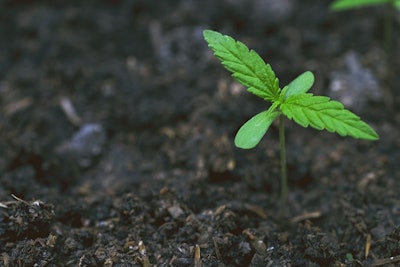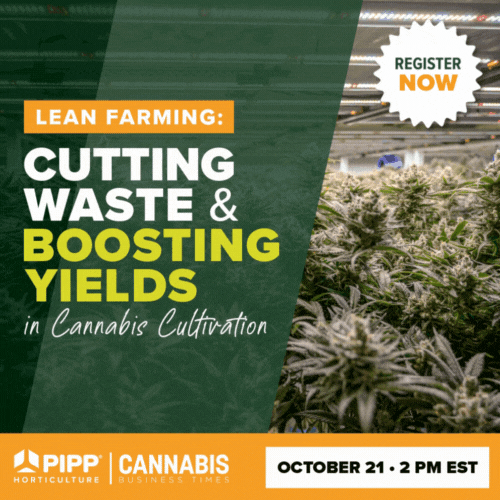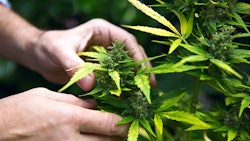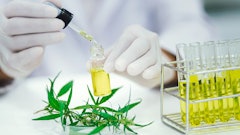
Innovative cannabis growing techniques such as Hügelkultur and lunar farming can have several benefits, according to Moon Made Farms founder and owner, Tina Gordon, who has seen broader terpene expressions in her plants and improved health in the land she farms in Southern Humboldt County.
Here, Gordon describes the alternative cultivation methods she has implemented at Moon Made and offers advice for other growers eyeing new techniques.
Cannabis Business Times: Which cultivation methods do you use at Moon Made Farms, and what benefits have you seen?
Tina Gordon: Moon Made Farms is located in Southern Humboldt County, 33.3 linear miles from the Pacific Ocean, 2,100 feet in elevation, on the leeward of a long inland mountain ridge. The farm has primarily southern exposure on slopes of rock and clay-dominant native soil. The semi-arid climate swings between a long, hot, dry summer and a winter/spring rain season that shifts between November and May. Within these lightly forested hills, Moon Made Farms is nestled in an old growth deciduous oak grove with red, white and live oak, with some madrone and bay. A native pond is held in a bowl at the top of the property that supports a range of wildlife above and below the ground.
The diverse ecosystem has a direct effect on all forms of life here on the mountain, including the cannabis. Our goal is to incorporate the native soil, humic material and surrounding biology by building Hügelkultur beds, boxes and mounds with inputs provided largely by the land. We utilize on-site composting, cover cropping, living mulch, companion planting, homemade extracts from accumulator plants from our gardens and the land, and integrated pest management to cultivate biodiverse living soil. It's a holistic process that involves assessing shifting natural resource potential, utilizing seasonal inputs and nurturing a balance in the plants by encouraging a living soil balance. Our goal is to respond to the natural forces to enable the genetics of the plants to fully express themselves in a way that is intimately tied to this unique environment. We believe that this influence affects their health and ultimately their contribution and utility as a powerfully healing and inspiring plant.
CBT: Can elaborate on Hügelkultur? How is it used in your operation, and what effect has it had on the plants?
TG: “Hügelkultur” means hill culture or hill mound. It's a technique permaculturists borrowed from Eastern European tradition. This is a design that involves piling wood, straw, leaves, compost and other biomass and allowing it to decay. The pile composts and the wood decomposes slowly over time. We've found that this method as applied to mounds, in beds and in trenches supports water retention and helps maintain a living soil balance. In our experience, it takes two years for a Hügelkultur to settle. The Hügelkultur beds at Moon Made Farms are now six years old. For the first three seasons, we observed the soil, finding balance. For the past three years, we've watched the plants in these beds thrive more each year as the Hügelkultur beds mature. The plants in the Hügelkultur beds this past year were the most vigorous on the farm.
CBT: Can you also provide more insight on lunar farming? How is it used at Moon Made, and what benefits does it provide?
TG: Years ago, I was up in the middle of the night, and light from a full blue moon was flooding the room. I had never seen anything like this while growing up in the city. I stepped outside and I realized I could easily walk around under the night sky. It was during this period of time when I was starting to cultivate cannabis that I began contemplating how the moon affects this photosensitive plant. It was then that I started tuning in to the subtleties of moonlight. I started researching lunar farming to learn it dates back centuries. Not only does the light cycle of the moon affect plant (and animal) life, but the gravitational pull of the moon influences the water that is within in the earth and plants—the movement of the ocean just being a very obvious example of this influence. So, from cracking seeds, to planting in the ground, to when the waiting is done on the property, all of this is performed around the moon cycle. For me, the gradual shifting of the sun is often hard to distinguish over the course of the summer, and I am surprised at the end of the year that we are back at the equinox, the great balance. But the moon [moves] daily and nightly. Still, when I look up in the mid-morning sky and see a three-quarter moon in broad daylight, it takes my breath away.
With this knowledge, I began to experiment with regenerative farming methods guided by the lunar calendar. Lunar farming [is] very useful for seasonal planning. This schedule aligns the plants with natural cycles and guides us when to germinate seeds, transplant, sow seeds and when to harvest. We integrate ancient and lunar techniques with more modern tools like automatic drip irrigation, laboratory testing, microscope use, organizational tools and sensor controls .
CBT: How does Moon Made Farms use native soil, and what impact does this have on the plants?
TG: Through study and trial and conversation with our regenerative community, we began to integrate existing soil with native soil on the property, regenerating it and taking care of it like the living thing that it is. This provides a seamless relationship with local microbiology, worms and insects, and other biology, and the difference has been profound.
CBT: What factors should cannabis cultivators consider when deciding whether to implement any of these alternative cultivation methods in their operation?
TG: Being in the hills and [practicing] terrace farming has taught me so much about micro-climates and micro-environments. The most important question a sungrown cannabis cultivator embracing natural farming can ask themselves is, "What is unique about the land I'm cultivating on?" This question will lead to an assessment of how the natural forces and the ecological makeup of the land coincide to create a unique environment. Elevation, average annual rainfall, air quality, geology, indigenous biology, water source and topography all contribute to the environment above and below the ground that the plants will live in. These environmental factors will inform and define their cultivation design. Whereas some Hügelkultur beds work on one hillside terrace of the farm, raised beds or Hügelkultur mounds work better in entirely different areas.
"The plants in the Hügelkultur beds this past year were the most vigorous on the farm."
-Tina Gordon, Founder and Owner, Moon Made Farms
Cultivators should also ask themselves, “What am I going gain by doing this, and what am I going to give back?” These traditional methods not only have the potential of producing better crops, [but] the decision has to [also] be made [based on] whether we want to produce a better life for the land, our communities and ourselves. There is a joy in knowing and seeing the results of aligning with the natural cycles of the earth.
Editor’s Note: This interview has been edited for style, length and clarity.

























